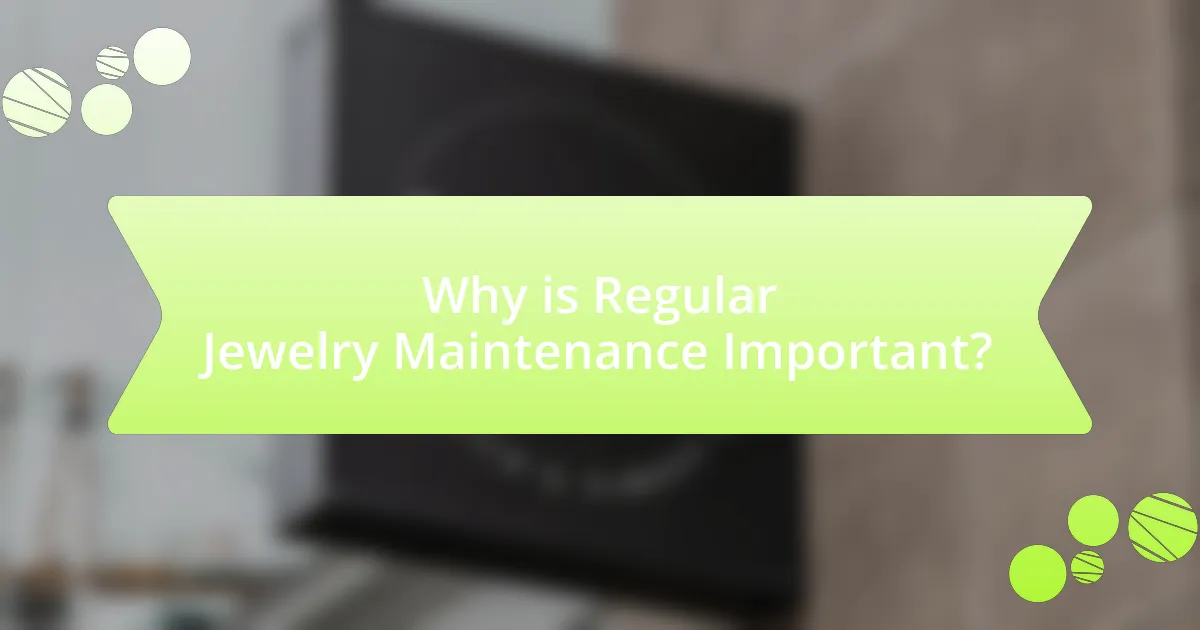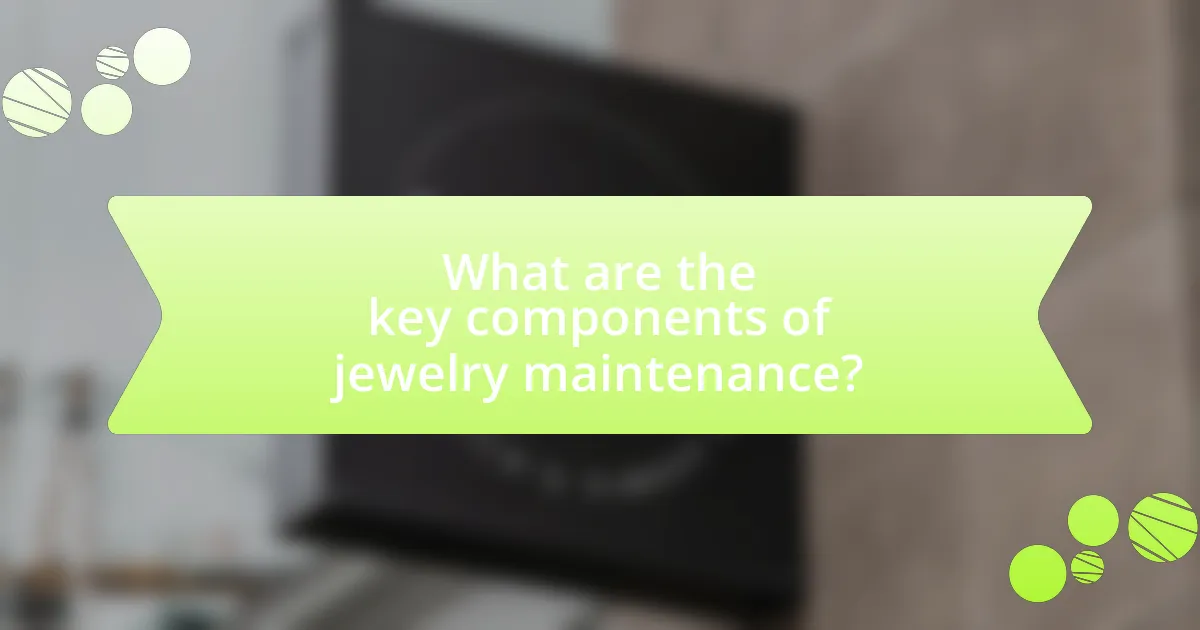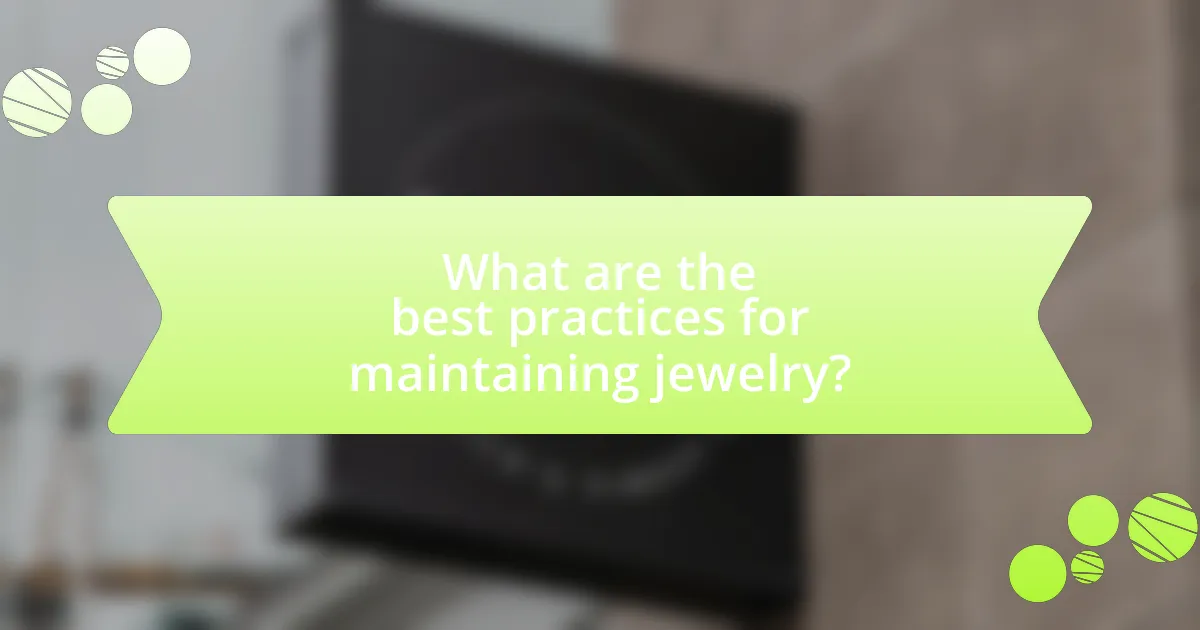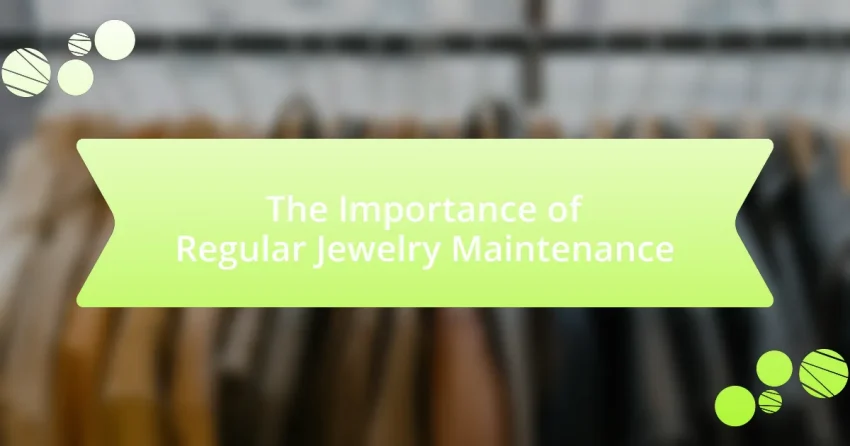Regular jewelry maintenance is essential for preserving the integrity, appearance, and value of jewelry pieces. This article outlines the importance of routine cleaning, proper storage, and periodic professional inspections to prevent damage, loss, and health hazards associated with neglect. It highlights the risks of dirt accumulation, improper storage, and the need for timely repairs to extend the lifespan of jewelry. Additionally, the article provides practical tips for safe cleaning methods, identifying signs of wear, and avoiding common maintenance mistakes, ensuring that jewelry remains in optimal condition over time.

Why is Regular Jewelry Maintenance Important?
Regular jewelry maintenance is important because it preserves the integrity and appearance of the pieces, preventing damage and prolonging their lifespan. Regular cleaning removes dirt and oils that can cause tarnishing or corrosion, while inspections can identify loose stones or weak clasps before they lead to loss or breakage. According to the Gemological Institute of America, routine maintenance can help maintain the value of fine jewelry, ensuring that it remains in optimal condition for years to come.
What are the potential risks of neglecting jewelry maintenance?
Neglecting jewelry maintenance can lead to significant risks, including damage, loss of value, and potential health hazards. Over time, dirt and oils can accumulate on jewelry, causing tarnishing or corrosion, which compromises the integrity of the piece. For example, gemstones may become loose in their settings, increasing the risk of losing them. Additionally, neglecting maintenance can result in the weakening of clasps and chains, leading to breakage and loss of the entire piece. Furthermore, unmaintained jewelry can harbor bacteria, posing health risks when worn. Regular cleaning and inspections can mitigate these risks, ensuring the longevity and safety of jewelry items.
How can dirt and grime affect the appearance of jewelry?
Dirt and grime can significantly diminish the appearance of jewelry by creating a dull, tarnished look that obscures its shine and brilliance. When jewelry accumulates dirt, oils, and other residues, these substances can form a film that reduces light reflection, making the piece appear less vibrant. For instance, gemstones can lose their luster, and metal surfaces can become discolored or tarnished due to prolonged exposure to contaminants. Regular cleaning and maintenance are essential to preserve the jewelry’s aesthetic appeal and ensure it remains visually striking.
What damage can occur from improper storage of jewelry?
Improper storage of jewelry can lead to various forms of damage, including tarnishing, scratching, and loss of structural integrity. Tarnishing occurs when metals like silver and copper react with moisture and air, resulting in discoloration. Scratching can happen when jewelry pieces are stored together without protective barriers, causing them to rub against each other. Additionally, improper storage can lead to the bending or breaking of delicate components, such as chains or clasps, due to pressure or weight from other items. These damages highlight the necessity of proper storage solutions, such as using individual pouches or compartments, to maintain the jewelry’s condition and longevity.
How does regular maintenance extend the life of jewelry?
Regular maintenance extends the life of jewelry by preventing damage and wear through consistent cleaning, inspection, and repairs. Jewelry, especially pieces with intricate designs or gemstones, can accumulate dirt, oils, and debris that may lead to tarnishing or weakening of settings. For instance, routine cleaning removes these harmful substances, preserving the luster and integrity of the materials. Additionally, regular inspections can identify loose stones or weakened clasps before they result in loss or breakage, allowing for timely repairs. According to a study by the Gemological Institute of America, properly maintained jewelry can last significantly longer than neglected pieces, emphasizing the importance of proactive care.
What specific maintenance tasks can prevent wear and tear?
Regular cleaning, proper storage, and periodic professional inspections are specific maintenance tasks that can prevent wear and tear on jewelry. Cleaning jewelry removes dirt and oils that can cause damage over time, while proper storage in a soft-lined box or pouch prevents scratches and tangling. Additionally, professional inspections can identify loose stones or weakened settings before they lead to loss or damage, ensuring the longevity of the piece. Regular maintenance, such as these tasks, is essential for preserving the integrity and appearance of jewelry.
How often should jewelry be professionally inspected?
Jewelry should be professionally inspected at least once a year. Regular inspections help identify any potential issues such as loose stones, worn prongs, or damaged settings, which can prevent costly repairs or loss of the jewelry. According to the American Gem Society, annual inspections are recommended to maintain the integrity and appearance of fine jewelry, ensuring it remains in optimal condition over time.

What are the key components of jewelry maintenance?
The key components of jewelry maintenance include regular cleaning, proper storage, and periodic professional inspections. Regular cleaning involves using appropriate solutions and tools to remove dirt and oils, which helps maintain the jewelry’s appearance and integrity. Proper storage requires keeping jewelry in a dry, organized space, ideally in separate compartments to prevent scratching and tangling. Periodic professional inspections allow for the identification of loose stones or wear and tear, ensuring that any necessary repairs are made promptly to avoid further damage. These practices collectively enhance the longevity and aesthetic appeal of jewelry.
What cleaning methods are safe for different types of jewelry?
Safe cleaning methods for different types of jewelry include using mild soap and water for gold and silver, a soft cloth for pearls, and specialized cleaners for gemstones. Gold and silver jewelry can be cleaned by mixing a few drops of mild dish soap with warm water, soaking for a few minutes, and gently scrubbing with a soft brush. Pearls require a damp cloth for cleaning, as they are sensitive to harsh chemicals. Gemstones, depending on their hardness, may need specific cleaners; for example, diamonds can be cleaned with a solution of water and ammonia. These methods are validated by jewelers who recommend gentle cleaning to avoid damage, ensuring the longevity of the jewelry.
How do you clean precious metals versus gemstones?
To clean precious metals, such as gold and silver, use a mild soap solution and a soft cloth or brush to gently scrub the surface, ensuring to rinse thoroughly with water afterward. This method effectively removes tarnish and dirt without damaging the metal. In contrast, cleaning gemstones requires a different approach; most gemstones can be cleaned with warm soapy water and a soft brush, but some, like opals and pearls, should only be wiped with a damp cloth to avoid damage. This distinction is crucial because certain cleaning methods can harm the integrity of gemstones, while precious metals are more resilient to gentle cleaning techniques.
What household items can be used for jewelry cleaning?
Household items that can be used for jewelry cleaning include baking soda, white vinegar, dish soap, and toothpaste. Baking soda acts as a gentle abrasive that can remove tarnish from metals, while white vinegar can dissolve mineral deposits and grime. Dish soap mixed with warm water creates a safe solution for cleaning various types of jewelry, and toothpaste can effectively polish metals due to its mild abrasive properties. These items are commonly found in homes and provide effective cleaning solutions without the need for specialized products.
How can you identify when jewelry needs maintenance?
Jewelry needs maintenance when you observe signs of wear, such as loose stones, tarnishing, or scratches. Loose stones indicate that the setting may be compromised, which can lead to loss of the gemstone. Tarnishing occurs due to exposure to moisture and air, particularly in metals like silver, and can affect the jewelry’s appearance. Scratches on the surface can diminish the shine and overall aesthetic. Regular inspections every six months can help identify these issues early, ensuring the longevity and beauty of the jewelry.
What signs indicate that a piece of jewelry is damaged?
Signs that indicate a piece of jewelry is damaged include visible scratches, loose stones, broken clasps, tarnishing, and discoloration. Scratches on the surface can compromise the integrity of the material, while loose stones may indicate that the setting is weakening, risking loss. A broken clasp prevents secure wearing, and tarnishing or discoloration often signifies chemical reactions affecting the metal, which can lead to further degradation. Regular inspections can help identify these issues early, ensuring the longevity of the jewelry.
How can you assess the condition of your jewelry at home?
To assess the condition of your jewelry at home, visually inspect each piece for signs of damage, such as loose stones, scratches, or tarnishing. This method allows you to identify any immediate issues that may require professional attention. Additionally, gently shake or tap the jewelry to check for any rattling sounds, which may indicate loose components. Regular cleaning with a soft cloth can also help maintain the jewelry’s appearance and reveal any hidden problems. According to the Gemological Institute of America, routine checks can prevent minor issues from escalating into costly repairs.

What are the best practices for maintaining jewelry?
The best practices for maintaining jewelry include regular cleaning, proper storage, and periodic professional inspections. Regular cleaning involves using a soft cloth to wipe down jewelry after each wear to remove oils and dirt, while gentle cleaning solutions can be used for deeper cleans, ensuring that the materials are safe for the specific type of jewelry. Proper storage requires keeping jewelry in a dry, cool place, ideally in a lined box or individual pouches to prevent scratches and tangling. Periodic professional inspections help identify any loose stones or wear that may require repair, thus prolonging the life of the jewelry. Following these practices can significantly enhance the durability and appearance of jewelry over time.
How should jewelry be stored to prevent damage?
Jewelry should be stored in a cool, dry place, ideally in individual compartments or soft pouches to prevent scratches and tangling. Storing jewelry in a lined jewelry box or using anti-tarnish strips can further protect against oxidation and tarnishing. According to the Gemological Institute of America, proper storage methods significantly reduce the risk of damage, ensuring the longevity and appearance of the pieces.
What types of storage solutions are recommended for different jewelry types?
For different jewelry types, specific storage solutions are recommended to maintain their condition and prevent damage. Soft fabric pouches are ideal for delicate items like pearls and opals, as they prevent scratching and minimize exposure to dust. For metal jewelry, such as gold and silver, using anti-tarnish cloths or boxes lined with anti-tarnish material helps reduce oxidation. Additionally, compartmentalized jewelry boxes are suitable for organizing various pieces, preventing tangling and scratching, particularly for necklaces and bracelets. Finally, for gemstone jewelry, using individual boxes or padded inserts can protect against chipping and scratching, ensuring longevity. These storage methods are supported by industry practices that emphasize the importance of protecting jewelry from environmental factors and physical damage.
How can you protect jewelry from environmental factors?
To protect jewelry from environmental factors, store it in a cool, dry place away from direct sunlight and humidity. This method prevents tarnishing and damage caused by moisture and UV exposure. Additionally, using anti-tarnish pouches or cloths can further shield jewelry from oxidation. Research indicates that exposure to air and moisture accelerates tarnishing, particularly in silver and copper alloys, making proper storage essential for maintaining the jewelry’s appearance and longevity.
What are some common mistakes to avoid in jewelry maintenance?
Common mistakes to avoid in jewelry maintenance include neglecting regular cleaning, using harsh chemicals, and failing to store jewelry properly. Regular cleaning prevents buildup of dirt and oils that can damage the jewelry over time. Harsh chemicals, such as bleach or ammonia, can corrode metals and dull gemstones. Proper storage, such as using a soft cloth or a dedicated jewelry box, prevents scratches and tangling, preserving the jewelry’s condition. These practices are essential for maintaining the longevity and appearance of jewelry.
Why is it important to avoid harsh chemicals when cleaning jewelry?
Avoiding harsh chemicals when cleaning jewelry is crucial because these substances can damage the metal and gemstones. For instance, chemicals like bleach or ammonia can cause discoloration, corrosion, or even structural damage to precious metals such as gold and silver. Additionally, certain gemstones, like pearls and opals, are particularly sensitive to harsh cleaners, which can lead to irreversible damage. Therefore, using gentle, pH-balanced cleaners ensures the longevity and appearance of jewelry, preserving its value and aesthetic appeal.
How can improper handling lead to jewelry damage?
Improper handling can lead to jewelry damage by causing scratches, breakage, or loss of stones. When jewelry is not stored correctly or is subjected to rough treatment, the delicate materials can become compromised. For instance, gold and silver can scratch easily when in contact with harder surfaces, while gemstones can loosen or chip if the jewelry is dropped or knocked against objects. Studies indicate that nearly 30% of jewelry damage occurs due to mishandling, emphasizing the need for careful maintenance and storage practices to preserve the integrity of the pieces.
What practical tips can help ensure effective jewelry maintenance?
To ensure effective jewelry maintenance, regularly clean your jewelry using a gentle solution of warm water and mild soap. This practice removes dirt and oils that can dull the appearance of the pieces. Additionally, store jewelry in a dry, cool place, preferably in a soft-lined box or pouch to prevent scratches and tangling. Regular inspections for loose stones or damaged clasps can help identify issues before they worsen, preserving the integrity of the jewelry. According to the Gemological Institute of America, proper care can extend the life of jewelry significantly, making these maintenance tips essential for longevity.
